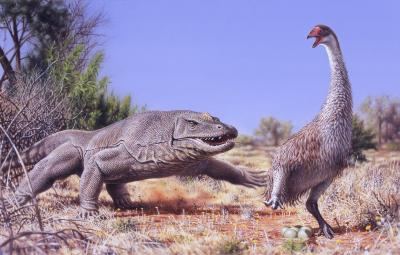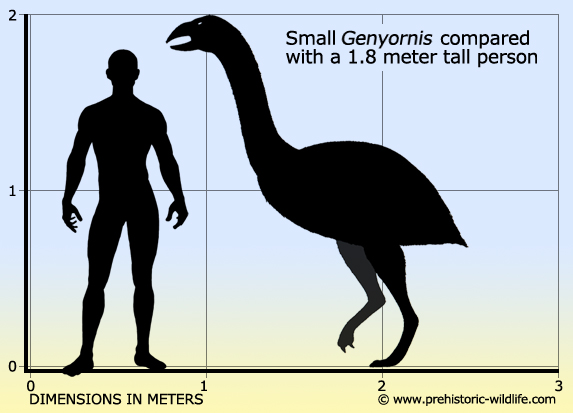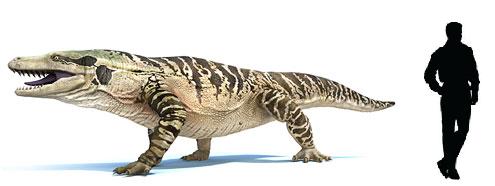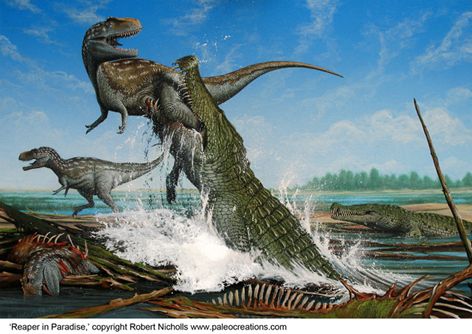It looks like you're using an Ad Blocker.
Please white-list or disable AboveTopSecret.com in your ad-blocking tool.
Thank you.
Some features of ATS will be disabled while you continue to use an ad-blocker.
13
share:
Wandering through a few news sources I frequent, this particular one jumped out to me. I always love thinking about what our ancestors may have seen,
or been in close contact with in recent history (recent as in according to the span of life on Earth ). This article gives you a glimpse on what
you may have faced if you were born 50,000 years ago (in Australia)

There you have it! doesn't look too terrifying does it? The flightless bird, to the right, is Genyornis newtoni. Looks pretty harmless, right?
That little lizard behind it is Megalania prisca. Both lived around 50,000 years ago, alongside the first Australian Humans.
So, why is this revealing? Let's look at the two creatures in perspective to a human

Genyornis newtoni is a near 7 foot tall, 500 pound bird with cantaloupe-sized eggs, in which humans ate.

Megalania prisca is a massive 1-ton predatory lizard, which probably ate humans (my own opinion, totally unfounded)
Are you terrified yet! or at the very least feeling a sudden urge to be the next Steve Irwin and pounce on one of them for study-purposes?
Source
Furthermore, we may have had a hand in wiping the Geynornis out through this predation.
source

There you have it! doesn't look too terrifying does it? The flightless bird, to the right, is Genyornis newtoni. Looks pretty harmless, right?
That little lizard behind it is Megalania prisca. Both lived around 50,000 years ago, alongside the first Australian Humans.
So, why is this revealing? Let's look at the two creatures in perspective to a human

Genyornis newtoni is a near 7 foot tall, 500 pound bird with cantaloupe-sized eggs, in which humans ate.

Megalania prisca is a massive 1-ton predatory lizard, which probably ate humans (my own opinion, totally unfounded)
Are you terrified yet! or at the very least feeling a sudden urge to be the next Steve Irwin and pounce on one of them for study-purposes?
Australia’s first human inhabitants cooked and ate the cantaloupe-sized eggs of Genyornis newtoni, a flightless bird that stood nearly seven feet tall and weighed 500 pounds, according to a new study led by Gifford Miller of the University of Colorado at Boulder. “We consider this the first and only secure evidence that humans were directly preying on now-extinct Australian megafauna. We have documented these characteristically burned Genyornis eggshells at more than 200 sites across the continent,” he said in a press release.
The bones of Australia’s extinct megafauna rarely survive in the harsh soil, leaving little chance to find evidence of early hunting activity. The burned eggshell fragments, however, were dated to between 54,000 and 44,000 years ago with optically stimulated luminescence dating, and radiocarbon dated to no younger than 47,000 years old. Analysis of amino acids in the eggshells indicate that the eggs had been cooked at one end with a localized heat source. Many of the burned eggshell fragments were also found in clusters. Miller and his team argue that “the conditions are consistent with early humans harvesting Genyornis eggs, cooking them over fires, and then randomly discarding the eggshell fragments around their cooking fires.”
Source
Furthermore, we may have had a hand in wiping the Geynornis out through this predation.
The demise of the ancient megafauna in Australia (and on other continents, including North America) has been hotly debated for more than a century, swaying between human predation, climate change and a combination of both, said Miller. While some still hold fast to the climate change scenario -- specifically the continental drying in Australia from about 60,000 to 40,000 years ago -- neither the rate nor magnitude of that change was as severe as earlier climate shifts in Australia during the Pleistocene epoch, which lacked the punch required to knock off the megafauna, said Miller.
Miller and others suspect Australia's first inhabitants traveled to the northern coast of the continent on rafts launched from Indonesian islands several hundred miles away. "We will never know the exact time window humans arrived on the continent," he said. "But there is reliable evidence they were widely dispersed across the continent before 47,000 years ago."
Evidence of Australia megafauna hunting is very difficult to find, in part because the megafauna there are so much older than New World megafauna and in part because fossil bones are easily destroyed by the chemistry of Australian soils. said Miller.
"In the Americas, early human predation on the giant animals in clear -- stone spear heads are found embedded in mammoth bones, for example," said Miller. "The lack of clear evidence regarding human predation on the Australia megafauna had, until now, been used to suggest no human-megafauna interactions occurred, despite evidence that most of the giant animals still roamed Australia when humans colonized the continent."
source
edit on 29/1/16 by Ghost147 because: typo
Good read... Do you know what happened to them? At some point, the aboriginals came along and were pushed back by British convicts after they were
colonized on Australia, or New South Wales.
a reply to: Ghost147
I was reading "on this day" a couple days ago and it was Australia Day and I read about all that, haha. 1700's I believe.
Not to get off topic though... I wonder if the Genyornis Newtoni was a red meat bird or like a chicken... That's a lot of meat.
I was reading "on this day" a couple days ago and it was Australia Day and I read about all that, haha. 1700's I believe.
Not to get off topic though... I wonder if the Genyornis Newtoni was a red meat bird or like a chicken... That's a lot of meat.
originally posted by: LSU0408
a reply to: Ghost147
Not to get off topic though... I wonder if the Genyornis Newtoni was a red meat bird or like a chicken... That's a lot of meat.
They would almost certainly have Red Meat.
Take a look at Ostrich, for example. Ostrich are part of the Ratite family, which are almost all large, flightless birds, all of which have red meat. Even though most poultry is white, ostrich meat is red. And this red meat, which looks and tastes much like beef, is lower in fat, calories and cholesterol than not only beef, but also white meats like chicken and turkey. All ratites have red meat. It has to do with their muscles. On the next page, we'll find out what meat actually is and what makes ostrich meat red instead of white.
Even though Genyornis Newtoni is of a different family, it used to be classified under Struthioniformes, which is where Ostrich are. They are now classified Anseriformes, but the two are closely related.
Something I have considered as I have read about megafauna over the years (in particular, the terror birds you are discussing here). And it seems to
me that Mazlow's Hierarchy could give some insight into the excruciatingly slow bootstrap that humanity had. Its not like we only started farming
because we suddenly were able to digest grain and milk....the opposite actually happened. We gained the ability to digest milk and grain (gluten) by
eating it and just developing the ability through a few generations.
Things like farming would have been impossible in the days of megafauna. At least from the perspective of what we typically call farming. Could you imagine keeping these animals out of your crops? How on God's earth would one go about domesticating an animal of that size? I mean, I can't imagine what crazy S.O.B.'s decided to domesticate the Auroch. I shudder to think about the carnage that actually created.
Perhaps the Quaternary Extinction Event, which killed off the megafauna, was the impetus for human changing from hunter/gatherer to agrarian? On the one hand you have the massive reduction in large predators that they were running for their lives from. On the other hand you have the massive loss of resource that animals like the mammoth had. I guess if you have a third hand, the larger scavengers and herbivores leaving would also make agrarian culture a little easier.
With agrarian culture, you have not only the opportunity but the need to begin things like astronomy, math, record keeping, etc.
Good thread. Thanks for sharing....i can imagine how utterly terrifying it would have been to live at that time. With only a spear/atlatl.
Things like farming would have been impossible in the days of megafauna. At least from the perspective of what we typically call farming. Could you imagine keeping these animals out of your crops? How on God's earth would one go about domesticating an animal of that size? I mean, I can't imagine what crazy S.O.B.'s decided to domesticate the Auroch. I shudder to think about the carnage that actually created.
Perhaps the Quaternary Extinction Event, which killed off the megafauna, was the impetus for human changing from hunter/gatherer to agrarian? On the one hand you have the massive reduction in large predators that they were running for their lives from. On the other hand you have the massive loss of resource that animals like the mammoth had. I guess if you have a third hand, the larger scavengers and herbivores leaving would also make agrarian culture a little easier.
With agrarian culture, you have not only the opportunity but the need to begin things like astronomy, math, record keeping, etc.
Good thread. Thanks for sharing....i can imagine how utterly terrifying it would have been to live at that time. With only a spear/atlatl.
Ugh: Fancy going out this evening and eating some egg tonight, Ogg?
Ogg: Hey man, Sure! Where do you want to go?
Ugh: I'm thinking of going to Mountain Ridge, unless you know somewhere better?
Ogg: What? Are you crazy?
Ugh: Well, we could always have some fresh lizard?
Ogg: Bleuch! OK, let's get some eggs.
Ugh: Great! OK, you know the plan. After we find a nest, someone distracts the birds while the others run in and grab the eggs. So put your running furs on.
Ogg: What? I was the runner last time. It's your turn.
Ugh. But I'm the only one that knows how to make fire and cook eggs properly. No cook, no omelette. So you'll have to be runner.
Ogg. Grrrrr.
Ogg: Hey man, Sure! Where do you want to go?
Ugh: I'm thinking of going to Mountain Ridge, unless you know somewhere better?
Ogg: What? Are you crazy?
Ugh: Well, we could always have some fresh lizard?
Ogg: Bleuch! OK, let's get some eggs.
Ugh: Great! OK, you know the plan. After we find a nest, someone distracts the birds while the others run in and grab the eggs. So put your running furs on.
Ogg: What? I was the runner last time. It's your turn.
Ugh. But I'm the only one that knows how to make fire and cook eggs properly. No cook, no omelette. So you'll have to be runner.
Ogg. Grrrrr.
originally posted by: Ghost147
originally posted by: LSU0408
a reply to: Ghost147
Not to get off topic though... I wonder if the Genyornis Newtoni was a red meat bird or like a chicken... That's a lot of meat.
They would almost certainly have Red Meat.
Take a look at Ostrich, for example. Ostrich are part of the Ratite family, which are almost all large, flightless birds, all of which have red meat. Even though most poultry is white, ostrich meat is red. And this red meat, which looks and tastes much like beef, is lower in fat, calories and cholesterol than not only beef, but also white meats like chicken and turkey. All ratites have red meat. It has to do with their muscles. On the next page, we'll find out what meat actually is and what makes ostrich meat red instead of white.
Even though Genyornis Newtoni is of a different family, it used to be classified under Struthioniformes, which is where Ostrich are. They are now classified Anseriformes, but the two are closely related.
It tastes very much like lean beef. I was in Curacao in August and they have one of the largest Ostrich Farms outside of Africa. They also have a restaurant on site where you can order Ostrich Steaks, Ostrich Burgers and other various dishes. It was quite good.
One Ostrich egg gives the equivalent of 2 1/2- 3 dozen chicken eggs so at their size, even one Genyornis Newtoni egg would feed quite a few people. If the HSS who made their way there were hunting them for meat and eggs, I can see how they went extinct as quickly as they did. Eating all the eggs means fewer make it to maturity and hunting off mature individuals leads to fewer eggs being laid.
new topics
-
Bizarre Labour Party Tic Toc Video Becomes Even More Embarrassing
Regional Politics: 40 minutes ago -
Potter to WHU
World Sports: 6 hours ago -
Dr. Demento
Music: 8 hours ago -
The elephant in the room (wearing a hoodie)
US Political Madness: 8 hours ago
top topics
-
The elephant in the room (wearing a hoodie)
US Political Madness: 8 hours ago, 14 flags -
To become president, Zelensky had to learn Ukrainian
Political Conspiracies: 14 hours ago, 8 flags -
Dr. Demento
Music: 8 hours ago, 6 flags -
Bizarre Labour Party Tic Toc Video Becomes Even More Embarrassing
Regional Politics: 40 minutes ago, 3 flags -
Potter to WHU
World Sports: 6 hours ago, 2 flags
active topics
-
The Fight for Election Integrity Continues -- Audits, Criminal Investigations, Legislative Reform
2024 Elections • 4373 • : xuenchen -
President Carter has passed
Mainstream News • 50 • : xuenchen -
Los Angeles brush fires latest: 2 blazes threaten structures, prompt evacuations
Mainstream News • 198 • : Oldcarpy2 -
What Comes After January 20th
Mainstream News • 36 • : cherokeetroy -
Bizarre Labour Party Tic Toc Video Becomes Even More Embarrassing
Regional Politics • 1 • : chiefsmom -
Potter to WHU
World Sports • 3 • : gortex -
The Truth about Migrant Crime in Britain.
Social Issues and Civil Unrest • 42 • : gortex -
Post A Funny (T&C Friendly) Pic Part IV: The LOL awakens!
General Chit Chat • 8007 • : underpass61 -
Planned Civil War In Britain May Be Triggered Soon
Social Issues and Civil Unrest • 29 • : AdultMaleHumanUK -
The elephant in the room (wearing a hoodie)
US Political Madness • 19 • : xuenchen
13


